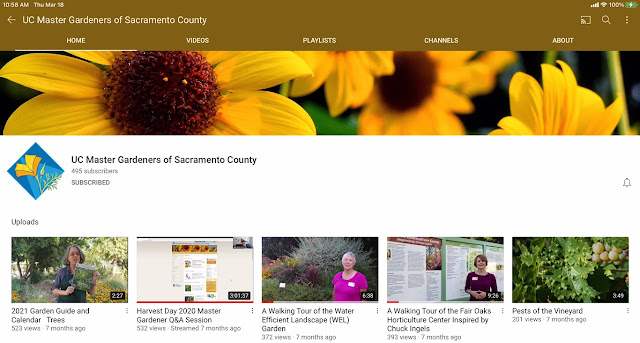

|
|
|
New YouTube video available for viewing Friday; check out others, too
While you're waiting for this video to drop, check out the other videos on the Sacramento master gardeners' YouTube channel . If you subscribe to the channel, you'll get notifications of any new ones.
Many of the videos already there were filmed for last summer's virtual Harvest Day. Some that are relevant for early spring gardening include:
Make Your Garden Wildlife Friendly
Composting: ABCs of Building a Successful Compost Pile
On the Sacramento County YouTube home page is also a link to the statewide UCCE master gardener YouTube channel. The latest video there is How to Design a Home Vegetable Garden.
Of course the advantage to videos is viewing them at any hour, and as many times as desired. I really need to watch that Sharpening Hand Pruners video again!
To see what else the Sacramento County master gardeners have to offer, including many planting and growing guides, visit their website, http://sacmg.ucanr.edu/ .
-- Kathy Morrison
Comments
0 comments have been posted.Sacramento Digs Gardening to your inbox.
Sites We Like
Garden Checklist for week of July 21
Your garden needs you!
* Keep your vegetable garden watered, mulched and weeded. Water before 8 a.m. to reduce the chance of fungal infection and to conserve moisture.
* Feed vegetable plants bone meal, rock phosphate or other fertilizers high in phosphate to stimulate more blooms and fruiting. (But wait until daily high temperatures drop out of the 100s.)
* Don’t let tomatoes wilt or dry out completely. Give tomatoes a deep watering two to three times a week.
* Harvest vegetables promptly to encourage plants to produce more. Squash especially tends to grow rapidly in hot weather. Keep an eye on zucchini.
* Pinch back chrysanthemums for bushy plants and more flowers in September.
* Remove spent flowers from roses, daylilies and other bloomers as they finish flowering.
* Pinch off blooms from basil so the plant will grow more leaves.
* Cut back lavender after flowering to promote a second bloom.
* It's not too late to add a splash of color. Plant petunias, snapdragons, zinnias and marigolds.
* From seed, plant corn, pumpkins, radishes, winter squash and sunflowers.